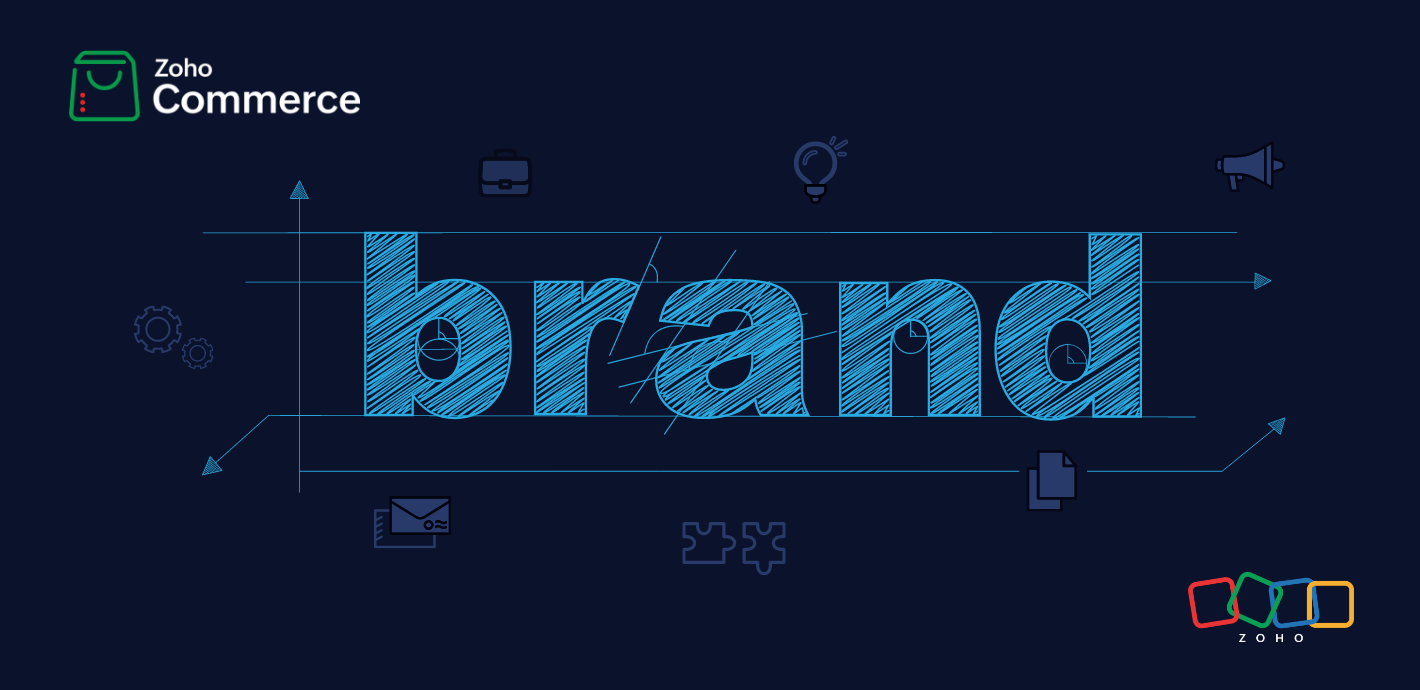In the world of ecommerce, much like any other business, the need for branding cannot be overstated. Whether you're trying to build a business from scratch or scale your local shop, you need to attract new customers from around the world.
As a businessperson, you will need to roll up your sleeves and tackle the challenge of building a highly perceptible brand that will further lay the path to your business's growth. To grow sustainably, you need to have a brand customers identify with and recall without you spending your time, effort, and money, repeatedly to bring them back. You need to brand your business well even if all you're looking to do is attract funding to your business, whether it be from venture capitalists, Amazon aggregators, or even your rich eccentric uncle.
What is a brand?
Before trying to crack open the hard nut that is ecommerce branding, here is a simple definition of "brand," beyond the jargon. In the words of Seth Godin:
A brand is the set of expectations, memories, stories and relationships that, taken together, account for a consumer’s decision to choose one product or service over another.
If the consumer (whether it’s a business, a buyer, a voter or a donor) doesn’t pay a premium, make a selection or spread the word, then no brand value exists for that consumer.
Building a brand - Breaking it down
When building an ecommerce brand (or any brand, for that matter), what you're trying to achieve is three-fold: expectations, memories, and relationships.
Expectations
Gauging your customer's expectations is key to building a strong brand. Knowing the things they look for in a brand will help you fine tune your offerings and communication to deliver on their expectations.
This is separate from your products.
No, this doesn't mean to imply your products aren't a part of your brand equation or brand communication. However, it can't be overstated that, besides the products, your brand is about the connection you establish with your customer, and how you engage with them.
Introduce your brand
When your audience knows the intention behind the existence of your brand or your origin story, your ethics, and if their interaction with your brand makes them feel a certain connection, their expectations will be met. You will be transcending the boundaries of a commercial relationship. You will know what has struck a chord with your customers from their interactions with you or what they've read about you online, and you can continue to build your brand and success on that.
Tell your brand story
There are going to be scores of brands that will sell what you sell, and may even imitate the same unique selling points (USPs) as yours. So, what binds your customers to you then? Your values, core beliefs, the products, and most importantly, how you make them feel. The most powerful way to communicate with them is to leverage the art of storytelling.
Start with who you are. Tell your visitors about your company, where you are from, why you do what you do, and most importantly what you have to sell or offer. (There are some hilarious examples online of websites that forget to mention what exactly they actually do amid all the fluff. You can always learn what not to do from them.)
Visican, a luxury packaging company, communicates this concisely. One glance is enough for you to know where they are from, what they manufacture, how long they have been in the industry, a handful of their clientele, and even the certification they have earned.
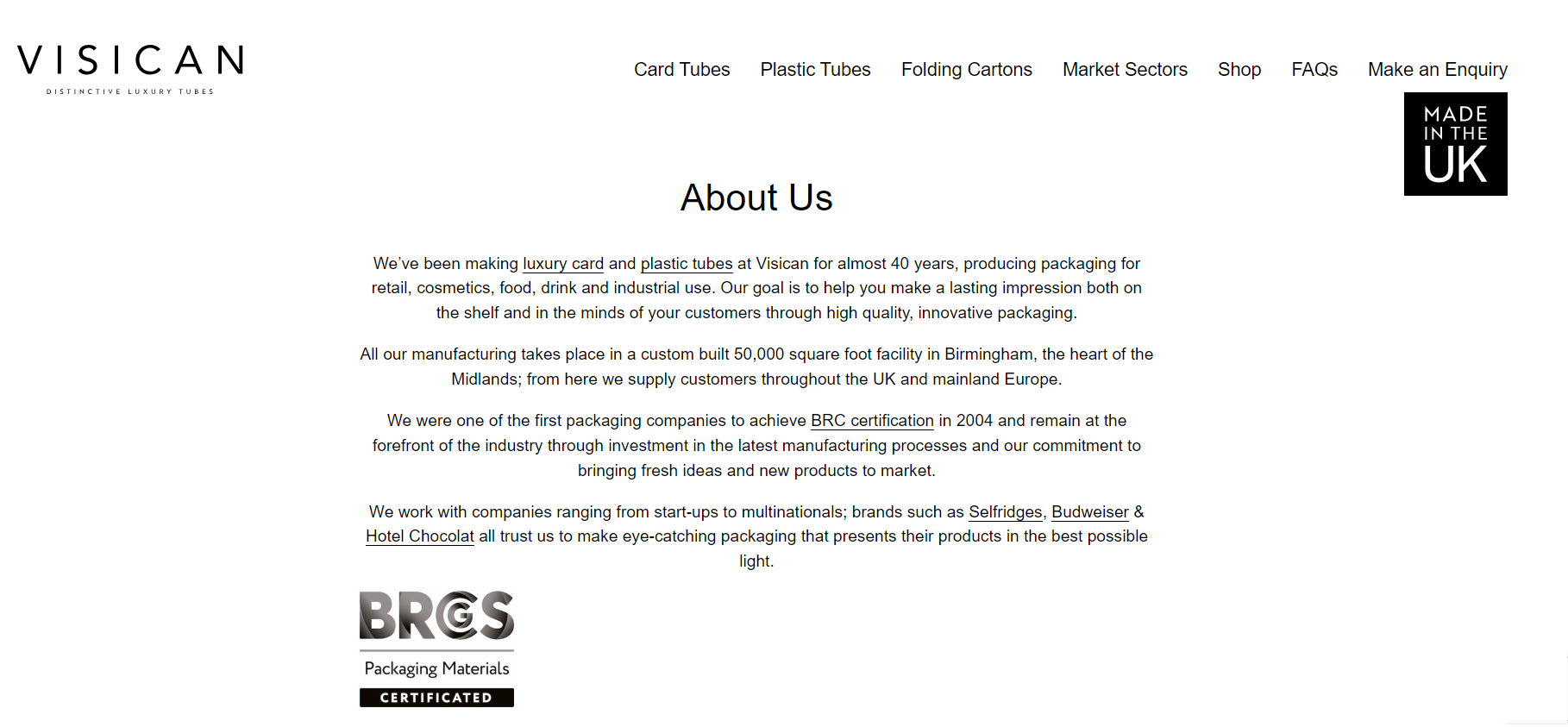
Talk about your company's values
Then, discuss what you care about. This adds to your narrative of why you started your business. Talk about the values your company holds, and how they derived from what you care about, and the things that affect you.
An example of this would be the apparel brand, Bombas. Their founders have often spoken about homelessness and how their research discovered that socks were the most required thing for people in need. On their website, they mention what they care about, and that is enough for people to connect with Bombas as a brand.

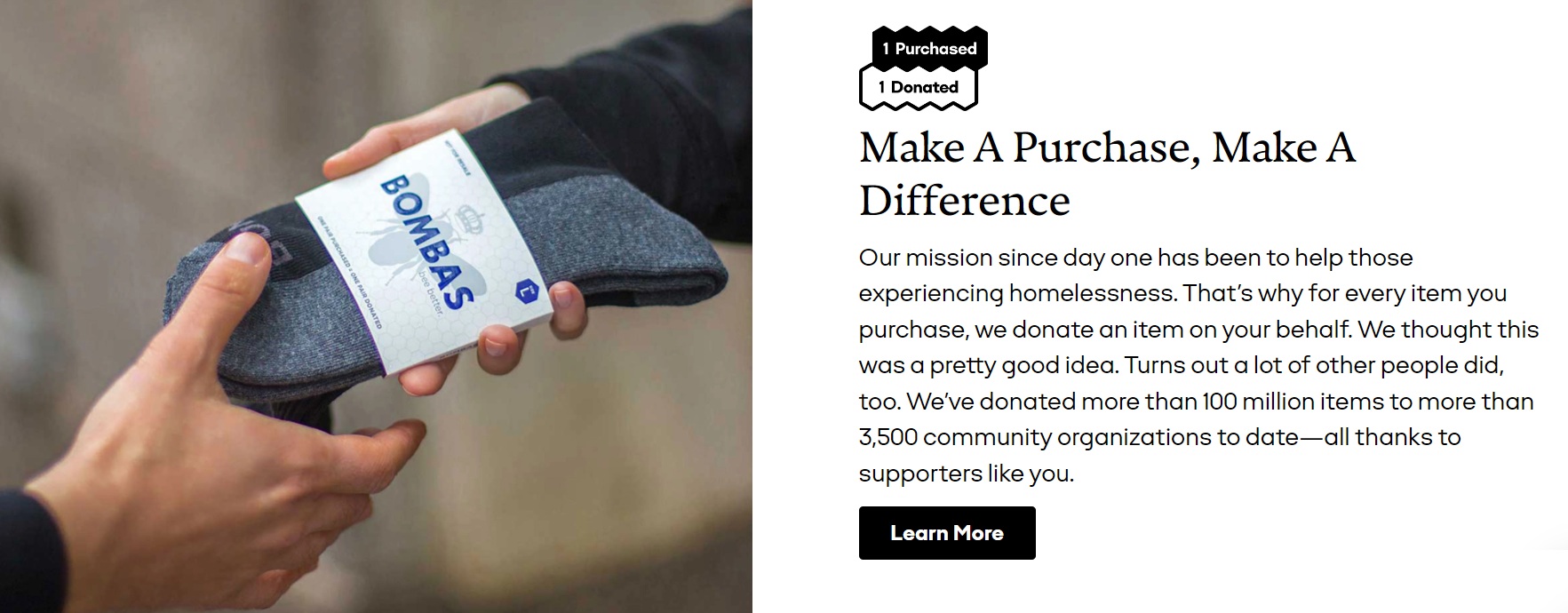
Next, touch on what you stand for and why you stand for it. When you talk about the values and beliefs you stand for, your customers will understand your conviction towards your business. This should be the background story of how or why you formed these values. The more sincere it sounds, the more your customers will root for your success.
Take a look at the About Us section of GoMacro. It has the right amount of sincerity, without losing focus on what they offer. They mention how much they care about plant-based lifestyle, and why!
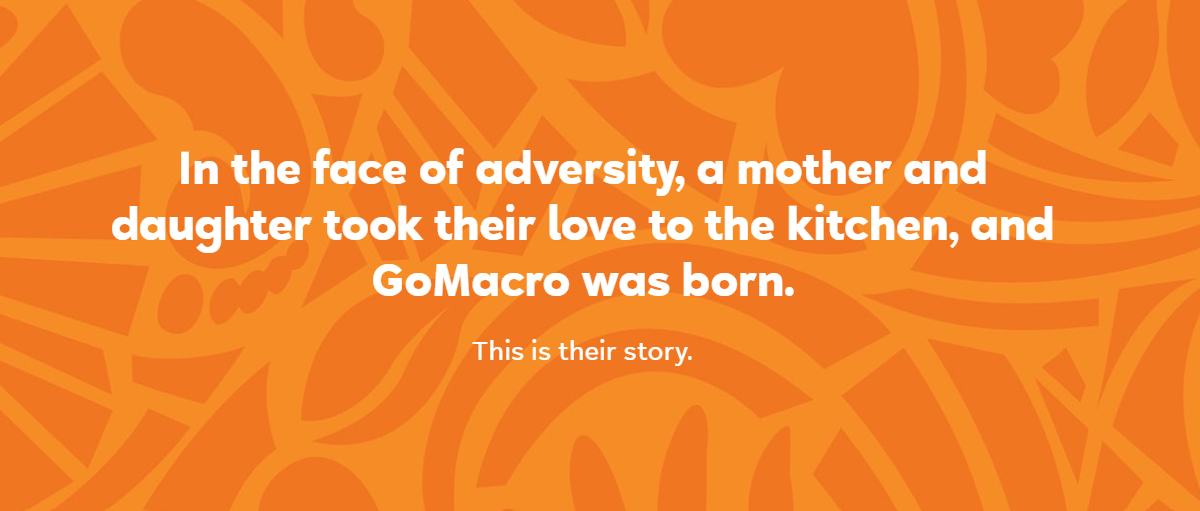
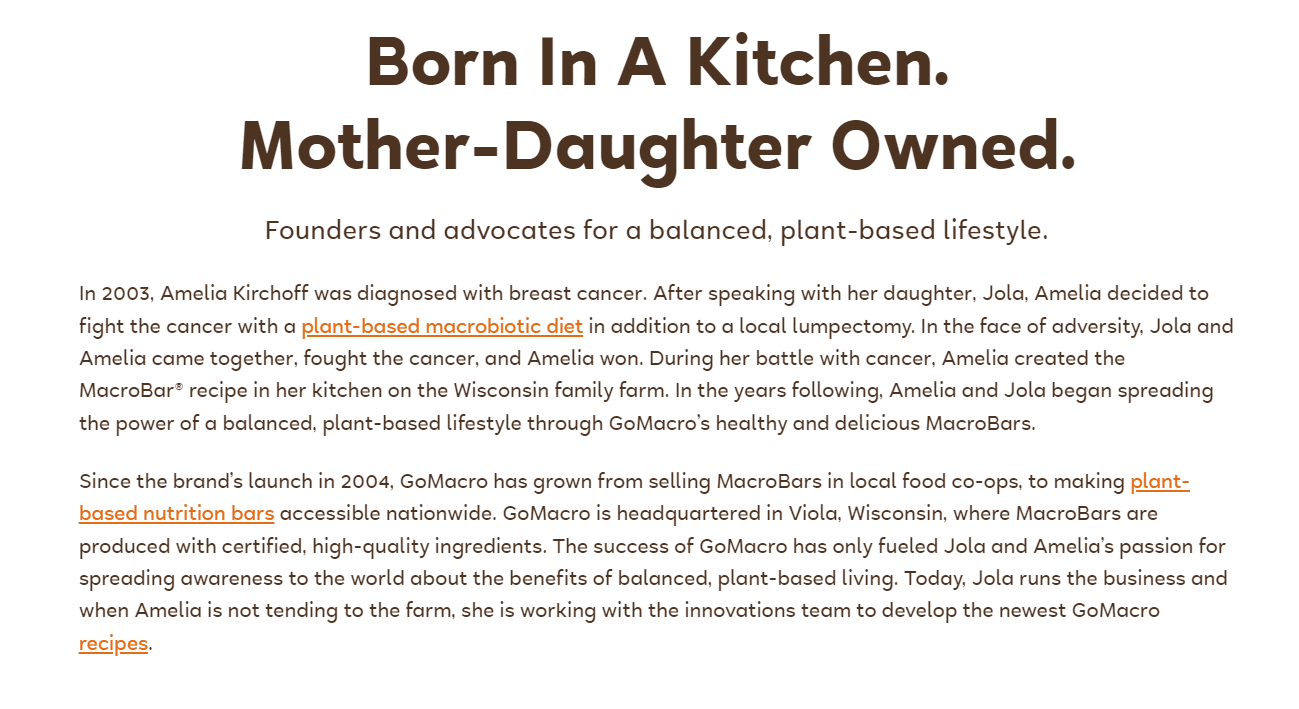
Check for other ways to leave a lingering impression of your brand. It could be a packaging insert with a succinct thank-you note or a quirky haiku inviting your customer to shop again with you. It could also be a Contact Us page with the same warmth or wackiness as your brand. Images, visuals, and colors you choose to use throughout your website, emails, and packaging can effectively communicate the brand, too.
There is also an aspect to storytelling where you connect your brand to your customer creatively, evoking their emotions whilst leaving a firm imprint about your brand values. It is proven that our brains are wired to respond to stories strongly. Using them to build your brand can help you reach your audience. When you do that, remember to:
- Build a narrative; tell your story.
- Show your human side.
- Keep your audience in mind, making them the heroes of the stories (which also brings up your product).
- Weave in the message of how you will help the hero deal with the villain (their pain points).
- Consider data-driven storytelling as another option.
When Hinge realized how they are no different from any of their competitors, they decided to reinvent themselves. The app did not focus on swiping anymore, and instead encouraged conversations. They cleverly summed up the entire emotion in their ad (and also their website) called, The Dating Apocalypse. Not only did it create an interesting story that online daters could relate to, but they also built a website that states every annoying statistic on which they constructed the storyline.
Here's a complete guide and worksheet on how to tell your brand story.
Outline policies clearly
Clearly defined policies lead to customers building their expectations accordingly. Be it shipping, returns, refunds or any other policies, they need to be listed out without being hidden under ominous asterisk marks. The dot-com world, with its labyrinthine policies and rules, can confuse a purchaser. When your online store clearly defines them, you put your customers at ease, improve their trust levels, and encourage them to invest in your brand. It can even lead to increased profits and a better perception of your brand. Remember to never over promise and under deliver. In the words of Tom Peters, the famous business management writer:
With an explosion of competitors, many of them new and without track records, reliability, rather than overly aggressive promises, is the most valuable strategic edge, especially for the mid- to long-haul. While getting faster at responding to customers is imperative, living up to commitments has never been worth more.
Here is an instance of a brand that spelled out its policies in simple sentences. ModCloth makes their conditions clear for domestic and international shipping.
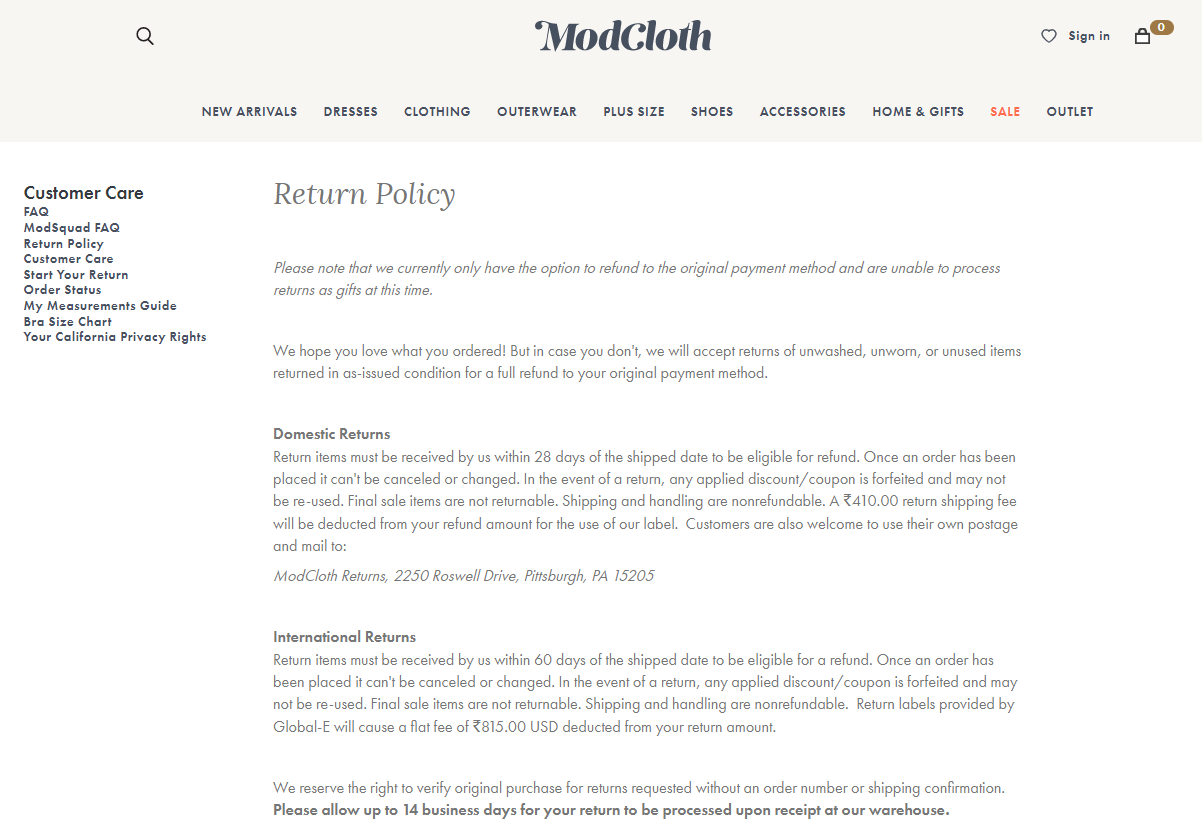
Memories
The second part of building an ecommerce brand is taking root in customers' memories. Every action and message conveyed by your brand is a chance to elicit a reaction from your users to evoke emotions. Through that, you can get a glimpse into the psyche of your audience to serve them better and to tailor your brand better. You'll end up creating an identity so strong and unique that your audience will want to be a part of it.
By creating this emotional connection with your audience, you're working towards getting and retaining their attention through sound communication across channels and by providing a great experience based on the user's needs and wishes. Make your communication proactive as well as reactive. Give them plenty of information, lend a sympathetic ear when they want you to understand their problem, and surprise them with discounts or offers. Once they see how genuine you are as a brand, they will start relating more to you. When they do that, they'll develop a specific liking for your brand. As they form memories of your brand based on these interactions, it will begin to stand out from your competition. This creates positive brand association.
Brands which play on creating positive memories and reinforce them continuously, have a clear advantage against those that don't. Cars or motorcycle brands do this well. Take the Royal Enfield (RE) story. While the rest of the world moved on from the classic British brand, RE continued to invest in India to form a series of memories through the generations. From selling 50,000 bikes in India, they are up to selling 800,000.
Relationships
The third part of building an ecommerce brand is relationships. Over time, your audience will stop looking at your brand as just an intangible distant entity. Instead, they will start perceiving it as a human, one they can interact with, understand, and experience, adding more meaning to the bond you forge. It's at that point when your brand forms a relationship with your customers. This unique bond, if well-balanced, can be as beneficial to the brand as it is for the buyers.
To build that kind of a relationship, understand what keeps customers happy and what upsets them. You need to be mindful of how you interact with them. If you are not considerate of their feelings, it will be a bad relationship. Learn to also engage with your customers like they are one of your own. For example, there are startups that take pride in the achievements of their customers and show it through glowing comments on their customer's social media post or even inviting them to their forum to talk about their feat. So, not just communication, but even gestures (online and offline) like these will show how genuine you are as a brand. When you do that, maintain a consistent tone in your communication; you could be their quirky friend, a vigilant neighbor, an old and wise relative, or a warm and supportive sibling. As you take these efforts, continue to deliver quality goods or services, for that is ultimately what the customer needs from you.
A customer who has a bond with your brand will choose you over other products, because they feel you understand them, and are there for them if they need you. That is the road to brand loyalty. According to the Wharton School of Business, a customer you acquire from word of mouth (WOM) has a 16-25% higher lifetime value than those you acquire from other sources. WOM will bring in loyal customers and increase your customer retention rate. They eventually become brand advocates, and find like-minded people with whom they'll form brand communities.
Caveats:
Ecommerce branding is crucial to your growth, and you now know three areas where you'll need to put your attention to establish your brand. However, you need to be mindful about a few things so you don't lose your patience or understanding of how it works.
- There are some things you cannot control, like the competition, the economy, the industry, and your partners. It's important to keep track of each of these and adjust your business to respond to the way the market is changing. Simultaneously, ensure you focus on what you do best, and continue to offer value to your customer through your products and services.
- Building a brand takes time. There's no brand bible that can help you establish your brand and business right away. Whatever effort you put in will take time to reach fruition. Don't expect overnight success.
- It is not about you, it is about your customer. You don't have to like or dislike specific things that act in any way as building blocks in your branding exercise, such as the product, marketing campaigns, visual aspects, and communication. Remember, if your customers like it, your branding works. If they strongly hate it, look into what has gone wrong and how you can fix it.
What's unique about ecommerce brands?
Building a brand is one thing, but an ecommerce brand is a little more unique.
With an ecommerce brand, you can establish a unique personality that sets you apart from competitors. It is not just a product or its USPs that you are selling, but rather a personality. Ranging from sophistication to ruggedness or sincerity, you will be creating a personality which will affect your customers, creating an emotional connection. And since you are an ecommerce brand, you will have all the liberty to build a unique persona that need not strictly adhere to the tone that is conventionally used to market a particular kind of product. Look at Selfridges or Enamor, lingerie brands that stopped marketing underclothing as sensual products or something as mere daily essentials. Instead, Selfridges showcased diverse women displaying strength and grace, that was choreographed by a choreographer from Royal Ballet. Enamor, on the other hand, removed the male gaze by introducing a playful tone in their campaign, with women appearing happy and confident in them.
Customer education is another key to achieving success. Since it is your product, you can take the liberty to teach the customer how to use or approach the product. This creates a unique approach to selling. By taking the time to educate your potential buyers, you can build trust to the point where the customer will look to you to make the purchase decision for them, rather than take a traditional compare-the-product-features-and-value approach. The biggest advantage of being an ecommerce brand is you can create a great FAQ (Frequently Asked Question) page, informative podcasts, fun videos, educational blogs and so much more!
Finally, a multichannel presence is something unavoidable for an ecommerce brand. Your products can be bought on your website, marketplaces, or just through social platforms. This is unique to ecommerce, as opposed to companies manufacturing, distributing, and retailing products in the traditional retail market.
If you understand these unique aspects of ecommerce brands, you will see the opportunity in developing one. Your brand will occupy the mind of your customer, rather than just representing a product or product category.
Brand prism: Ways to build brand identity
If you were to break the big block that is branding into small chunks that can be addressed, there would be six chunks: physique, personality, relationship, culture, reflection, and self-image. This is according to Jean-Noël Kapferer who described a brand through six different facets, which, when put together, would make a whole brand identity. This identity is popularly referred to by marketers as Brand Identity Prism.
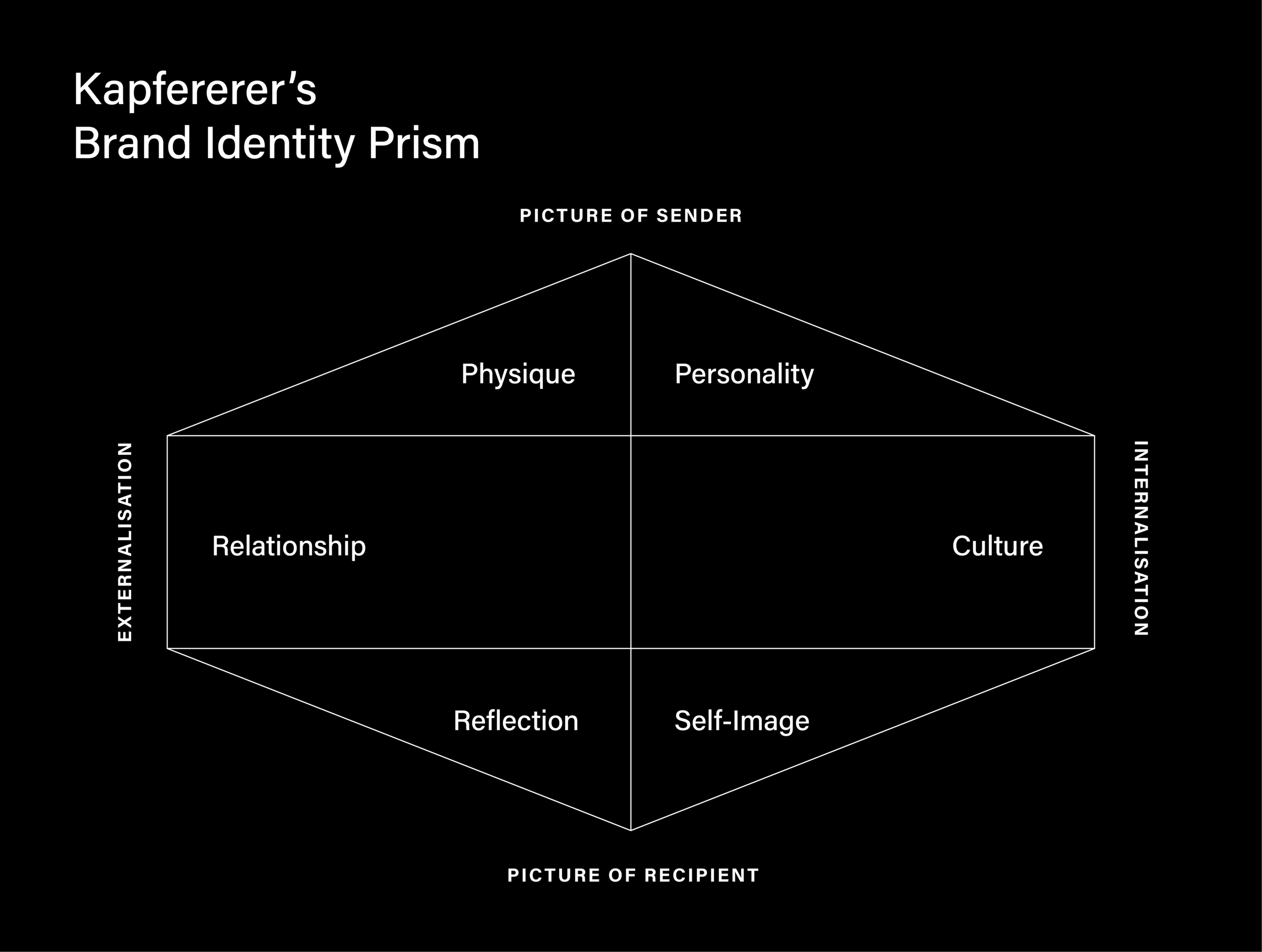
Source: Huddle Creative
The components of a brand prism are as follows.
Picture of the sender
This is how a brand makes itself known.
Physique
All the physical attributes, or rather the tangible elements, of a brand will fall under physique. Your logo, brand name, iconography, color schemes, font style, and the like can be counted as these attributes. We actually have a workbook on logo designing that can help you. Since it is digital, go for something simple. Finalize a style (combining font, name, colors, and logo) that works on your website, on social platforms, in print, on your letterhead, on your visiting card, on delivery boxes, and wherever else you can place them. Several years later, after your business is big and successful, transition to an updated design if the situation so demands.
Personality
If physique is all about how your brand appears, personality determines your brand's character. We mentioned how people view brands as humans; and just as humans, brands have characteristics traits. Everything from keywords, slogans, the tone of your communication, or your specific choice of words will help your audience figure out your brand's personality.
As an ecommerce business, every interaction of yours will be online, and everything online is permanent, so make sure to bring out your personality in these online interactions. A good example of this is Harley-Davidson, the American motorcycle maker. The brand promotes its distinct personality which exudes a free-spirited, adventurous, and rugged personality in all of its content.
Externalization
These are the efforts that build the perception of your brand with your audience.
Relationship
You read about all the ways creating a brand develops a relationship with your customers that goes beyond the financial one. You can establish this more personal relationship with great customer service, amazing online experiences, or in any other way discussed previously. Remember, the relationship is built with all that you offer beyond the product or service.
Internalization
This addresses the deeper, intangible aspects of your brand which helps build your brand identity with your employees and audience.
Culture
Your company culture lays the foundation of your brand. It is the story of how your company was born, why it is doing what it is doing, the people it wants to help, and everything else that tells your audience why your brand exists. All these are expressed in your brand's vision, mission, values, and principles.
There is also a company's internal culture. This refers to an organization's working style, office culture, and management policies which play a role in the construction of a brand's culture. It is the same reason why LinkedIn's posts on their menstrual leave policy or a brand's promise to aid underserved sections of society is lauded. Your brand's culture resonates with your audience because they associate themselves with you.
Picture of receiver
This is how a customer sees themselves and the brand.
Reflection
This is when a brand wants their customer to be a specific person. They come with particular qualities or personalities or belong to specific groups who will fit the brand's identity. This target audience is the ideal customer for the brand with whom you want to build a relationship. The customer will fit the idea of the buyer persona your brand has in mind.
For instance, there are cosmetic brands, like Too Faced and Tarte, that sell cruelty-free makeup to a growing population of eco-conscious people. They even have vegan products to cater to a wide range of people. Their ideal customers would be women and a selection of men, within the age group of 19-32, who could be vegans, climate activists, and similar environmental advocates.
Self-image
This is about a customer's aspirations, goals, and desires, as well as their traits and personality. It is the customer's understanding of self, influenced by the brand, which will help a company understand better who they are catering to. Knowing how a customer visualizes themselves will help your brand reach them faster.
Quick tips on building a brand
1. Market research
- What's your unique value prop? Know your USP.
- Who is your customer? Be sure of your primary target audience.
2. Build a buyer persona.
- What are their likes and dislikes?
- What do they really appreciate?
- How do you deliver it?
- Refine it over time.
3. Focus on your core market, the secondary will come.
- Sell to the core market.
- Focus all your efforts there.
- The secondary or fringe market will eventually fall into place.
4. Build a brand message.
- Build a message encompassing most of your communication.
- Leave room for creativity; don't box yourself in.
- Consistency is key.
5. Deliver a solid brand experience.
- Define this from product design to website copy, delivery and unboxing—think of everything.
- Deliver at every customer experience ranging from visiting your website to the unboxing, customer support, returns, and the like.
6. Build relationships.
- What are you doing to build an ongoing relationship with your customer?
- Can you partner with allied thoughtful brands to compound your message?
- Are you paying attention to what the market drivers (influencers) are saying?
- How can you collaborate with partners to drive your brand's popularity?
7. To advertise or not to advertise?
- If your business is sustainable and profitable, you should advertise. Otherwise, use organic means—there is more than enough traction to start with. Paid buyers are fickle. Focus on your MVP first.
- Keep to your values and focus on your core message first.
- Rule of thumb: Don't spend more than 30% of your profits before you can ensure your campaigns are profitable. Double down on profitable campaigns.
Conclusion
The ecommerce market is incredibly crowded. There were over 7M retailers in the space as of 2021, and that number is growing at breakneck speed. If you want to establish yourself as a successful business, branding is perhaps the biggest hurdle you need to jump to do that; everything else is fleeting.
Finally, reflect, refine, and add finesse continuously. If your customers are not happy, tweak things until they are. Remember, this is not about you, it is about your customer.

